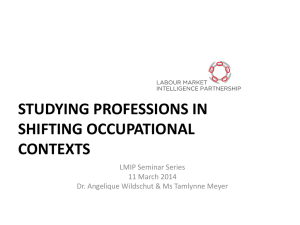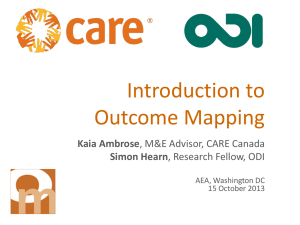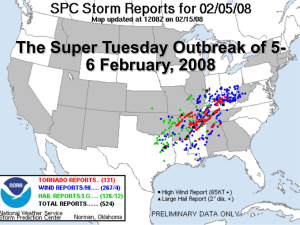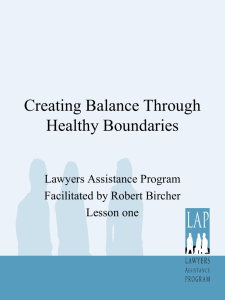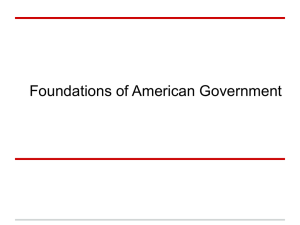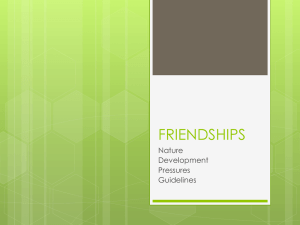Working with You is Killing Me
advertisement
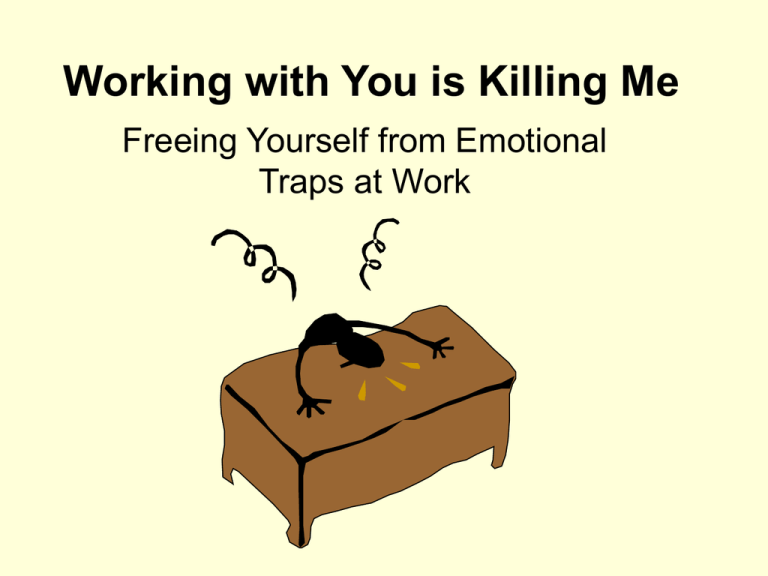
Working with You is Killing Me Freeing Yourself from Emotional Traps at Work This Presentation is Based on the Book, “Working with You is Killing Me” By Katherine Crowley and Kathi Elster Copyright 2006 – Warner Business Books This Class is About: Identifying when you are “hooked” to a stress inducing person or situation at work. Identifying Business Boundaries – Protecting yourself at work. Identifying and unhooking from Roles at work. Identifying and unhooking from Fatal Attractions at work. Take the Survey Activity: See if someone at work is killing you by filling out the inventory. Work on the Surface: • • • • • • • Making Money Delivering Goods and Services Producing results Crunching Numbers Meeting Deadlines Increasing Productivity Expanding to meet needs of the “customer” Work Below the Surface: What Lies Beneath: • • • • A Hotbed of Emotions People feeling anxious about performance Anger with Coworkers Misunderstood by Managers and Coworkers • Taking personal problems to and from work THIS CLASS IS NOT ABOUT CHANGING THEM. IT’S ABOUT CHANGING YOU. How do you know you are “hooked”? • Do you feel trapped by your circumstances? • Do you consistently have strong negative internal reactions to someone or something in your work environment? • Do you suppress your feelings? • Do you think your only options are to “suck it up” or quit? Warning signs that you may be Hooked: • Physical -- clenched teeth, stiff neck, tension headaches, tight chest, overheating, chills, stomach pain or nausea, shortness of breath, tingling arms, backaches, muscle spasms, facial twitches, insomnia, or fatigue. • Emotional -- anger, fear, anxiety, embarrassment, confusion, depression, repulsion, helplessness, or despair. • Mental - obsessive thinking, spacing out, constant distraction, paranoia, revenge fantasies, forgetfulness, or an inability to concentrate. If you can change your reaction, you’ll change your life. Step 1 – Unhook physically Step 2 – Unhook mentally Step 3 – Unhook Verbally Step 4 – Unhook with a Business tool Unhook Physically Calms the body and releases unwanted negative energy so that you can see your situation more clearly. Steps to Unhook Physically: • Begins with focusing your breath – relieves shallow breathing brought on by stress. Conscious, deep & gentle breathing lets you “scan” your body and see where you are holding tension. Gives you time to think • Release energy through physical activity Physical Unhooking Tip The more extreme your emotional response is to your external circumstances, the more vigorous your physical unhooking activities need to be. Unhook Mentally The Internal Version of talking yourself down off the ledge. It involves looking at a difficult situation from a fresh perspective. The goal is to view your circumstances objectively and see what practical options are available. Steps to Unhook Mentally: • Take an inventory of the situation: *What’s happening here? *What are the facts of the situation? *What’s their part? *What’s my part? *What are my options? Unhook Verbally Find the words (or sometimes the silence) to protect yourself and get out of a workplace trap. May involve finding ways to say no without jeopardizing your job, speaking up when you feel overlooked, or tolerating your boss’s temporary silence immediately after you ask for a raise. Steps to Unhook Verbally: • Take the verbal “high road” *contains no judgment, no anger and no accusations. *includes taking responsibility for your side of the situation. *it’s about communicating effectively, in a way that enables the listener to hear you and consider or ideas. *creates a bridge, not a wedge. Unhook with a Business Tool • A business tool is any standard procedure or written document used in a business setting. It includes contracts, timesheets, job descriptions memos, performance reviews, company policies and procedures, and other forms of documentation. Your Business Toolbox: • • • • • • • • Job Descriptions -- detailed explanations of the responsibilities that any job entails. Employee expectations/goals - concrete, measurable benchmarks for performance. Performance reviews -- quarterly, semiannual or annual appraisals of an employee’s overall job performance. Policies and procedures -- also know an an employee handbook, a document that delineates the company’s overall code of conduct. Disciplinary action forms -- written reports that document unsatisfactory employee behavior and forewarn he employee of possible termination. Memos emails, letters -- any form of written correspondence. Meeting agendas -- formal lists of topics to be discussed at meetings. Documentation -- a written record that provides factual information regarding and event, including time take and a description of the incident. Your Personal Unhooking Assessment Activity: Pick one person or situation in your workplace that has you hooked, and complete the assessment The Business of Boundaries Interpersonal Boundaries • The lines or parameters that define and protect the physical, emotional and psychological territory between individuals. They are far more difficult than geographic boundaries to discern. They are invisible and they differ from person to person. • Because they are imperceptible and unique to a person, they have to be communicated. Common Interpersonal Boundaries • • • • • • Time Personal space Keeping your Word Personal Information Emotional Expression Manners/Courtesy Noise Smells Food Language E-mail Cell Phones Personal Hygiene Is Someone Busting Your Boundaries? • If you are continually angry, upset, or complaining about someone or something, you probably need to set a boundary. • Unhook Physically: Take steps to release tension and calm down your nervous system. Boundary Busters tend to generate a good deal of physical stress. • Unhook Mentally: Assess your situation and devise options in terms of setting boundaries. • Unhook Verbally: Communicate our interpersonal boundary to the person or people who need to know. • Unhook with a Business Tool: Take concrete business actions to reinforce the boundary you’ve just set. Possible Outcomes: • Life is Beautiful-Receiver understands and agrees to fulfill your request • Partial Success-Receiver respects your boundary for a while but gradually relapses into their old behavior. You will have to reinforce the border in some way. • Continued Assault - Receiver doesn’t like or can’t respect your boundary and continues to invade your physical, emotional r psychological territory. You’ll have to take stronger measures. If the Role Fits…. Common Roles at Work: • The Hero- The need to be idolized compels them to outperform/produce. • The Caretaker - Feels responsible & tries to solve everyone’s problems. • The Rebel/Scapegoat - Bends the rules. • The Martyr - Wants recognition & praise for sacrifice & suffering. • The Entertainer - Uses jokes & humor to break the tension. • The Peacemaker - Does whatever it takes to keep the peace. • The Invisible One - Stays our of trouble by staying out of the spotlight. What’s Your Role? Activity: Look at the roles as defined by the authors and think about the role you might play at work…maybe it is one of these roles or maybe it is something unique to you…or a “combo-special”. Take some time and jot some notes about how that might fit for you. Fatal Attractions…haven’t we met before? The Most Common Brands • The Exploder - Starts out as Dynamic; turns into dynamite. • The Empty Pit - Starts out as very nice; turns into very needy. • The Saboteur - Stares out as sweet talk; turns into sabotage. • The Pedestal Smasher - Starts out as fawning; turns into fault-finding. • The Chip on the Shoulder - Starts out as appreciative;turns into argumentative. Life with a Fatal Attraction The 7 Stages of a Fatal Attraction at Work • Magnetism - The early intoxicating stage. • Consumption - The other person begins to exhibit their other side. • Rehearsal & Recovery - A time consuming, energy draining, attempt to control the relationship. • Conversion Obsession - You become obsessed with getting the other person to change. • Post-Interactive Heartburn - You are showing signs of emotional battle fatigue. • Allergic reaction - You develop automatic physical reactions to the other person. • Imprisonment - You are resigned to negative treatment and can’t imagine a better way. Advanced Unhooking • Detect - Is your body reacting to a stressful situation? • Detach - Separate yourself emotionally from the relationship. • Depersonalize - It’s not about YOU. • Deal - Devise and implement a strategy for managing the relationship. Beware Expect to be tested Corporate Culture Is this the right place for you?
